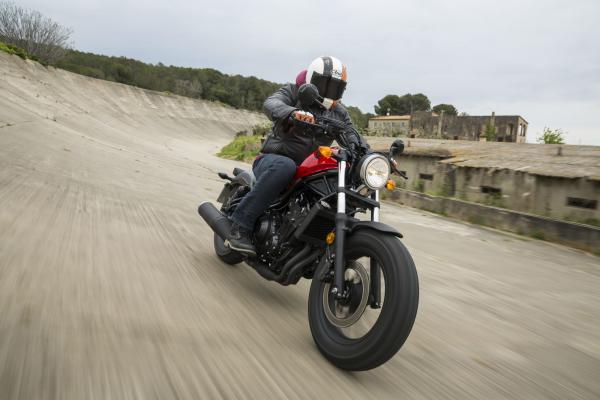
The Honda CMX500 Rebel “About as subversive as Terry And June” - full review here
By Simon Hargreaves
“NO, stop mucking about. Take the Rebel seriously, please.”
I’m talking to myself again, inside my knackered vintage Arai, as the rear end of the Honda CMX500 slews back in line, rear tyre hopping while the single front disc plugs its soft forks into Spanish tarmac and the ABS ties itself in knots.
But it’s hard to take the little Thai-built custom-cum-bobber seriously, for two reasons: firstly, it’s called a Honda Rebel ferchrissakes – which is an open goal for, “Honda Rebel; isn’t that a contradiction?”-type jokes. Harsh but fair: it’s not easy to imagine a less rebellious motorcycle. The CMX500 is about as subversive as Terry And June.
But the other reason it’s hard to take the Rebel seriously is because it’s so much fun. Perhaps unexpectedly, it’s a bike born with a smile on its face – a silly, thrashable giggle of a thing, like taking a bouncy but excitable spaniel for a walk. Despite of the name, cheesy styling, ho-hum performance and competent chassis, underneath the marketing bananas the Rebel is a fab wee runaround. In fact, you could say it’s a rebelation. It also costs £5,399, which is small change in new bike money.
The straight-faced spec sheet doesn’t blow the CMX’s riding punch-line. The Rebel’s motor is the A2 licence friendly 471cc parallel twin from the CBR500R, retuned via fuelling (not cam timing) to deliver the same claimed 45hp at the same 8,500rpm, and the same 32 lbft peak torque – but delivered 1,000rpm lower than the CBR500R, at 6000rpm (before you get too excited by those numbers, remember the original CB500 in the early 1990s made a measured 51hp).
The engine is the only CBR-related item on the Rebel; everything else is new. The motor is mated to a bespoke steel tube frame that loops round the back of the single seat, with a steel tube swingarm. Forks are unadjustable 41mm Showa, the rear shock are preload-adjustable Showa, and the single front disc is a 264mm one with a Nissin two-pot caliper. Pretty basic stuff. Wheels are 16-inch front and rear, kerb weight is a mere 190kg. Seat height is only 690mm, which is almost low enough to get both knees, let alone both feet, on the floor at standstill. The fuel tank holds 11.2 litres of happy juice.
And so, the Rebel is not a big bike. And anyone over 6ft will approach the CMX500 warily – it looks tiny and low, and you’re not sure how ridiculous you’ll look. The self-consciousness continues when you first sit on it – the seat is so deep, your bum so close to the floor and the tank so slim and steeply raked, it’s a bit like getting in a go-kart.
But the Rebel isn’t uncomfortable – bars meet you halfway, pegs are set low but mid-placed so you don’t slump on the base of your spine, your knees aren’t up by your ears, and the seat itself has room for manoeuvre. And anyway, a tankful only lasts 100 miles.
Controls are basic – the single round clock has inverted LEDs showing speed, fuel gauge and trips, but there’s no tacho. The Rebel has mandatory ABS, but no other frills – even the ignition lives on the left side of the steering column (not the right!).
And let’s pause here, before riding, to consider the Rebel’s styling. Honda say the project’s chief engineer, Keita Mikura (who also designed the Vultus), was inspired by a visit to the Bike Shed in London in 2013, which left him wanting to create a similar cool custom chop from the factory. Development of the Rebel shifted to North America – presumably because Europe’s not cool enough. And they’re good at choppery bobbers over there.
Fire up the little motor, clonk into first, and thud gently up the road. Steering is featherweight, flicking easily from side-to-side, and although suspension around town feels limited by travel and crashes the chassis into big pot-holes, otherwise it’s bouncy soft, not harsh. The front brake stops the plot efficiently, and the motor lets it bop along in the opposite direction at a reasonable rate. Its 45hp will never tear arms off, and the twin needs flogging mercilessly to maintain a sporting lick on twisty Barcelonaian back roads, but at around 80mph it’s content not to vibrate the rider to bits.
And here’s the thing; the Rebel’s individual parts combine to make a much greater whole. Dynamically, the CMX500 works more effectively than it needs to or it should – it can go round corners without grinding anything immediately (pegs go down, but not as soon as you’d think) and with a decent pace to upset a few bigger bikes. And it can be ridden right up to its limits without doing anything dangerous. Compared to a bike like, say, Yamaha’s £8,499 SCR950 – a cruiser-based scrambler with limited ground clearance and crude suspension – the £5,399 Honda Rebel is the model of civility. Hardly a rebel – but in this context that’s a good thing.
Honda admit the Rebel will be a bigger seller on the continent than in the UK – the kids in Paris and Madrid will love its light-hearted, simple character and easy-going vibe. But back in the UK I’m not so sure. The problem with production line imitations of artisanal hacked-up CX500s and the like, is authenticity. Genuine Bike Sheds are usually exactly that – sheds – and it’s the individual aesthetic that matters, not riding the bloody things. A mass produced bike like the Rebel has to live up to its name, and all the handling chops and surprising performance in the world is no use unless the machine is seen as a good base (a rebel base?) for modifying. And Honda need more than a pair of saddle-bags and a fly screen from their so-far limited Rebel accessories catalogue to stoke that particular fire.
But as a package – and a relatively cheap one – the Rebel defies its styling and price to deliver a typically Honda ride: pacey, controlled (mostly) and efficient.
Oh, and don’t be surprised to the see a Rebel-based Honda Scrambler in the near future – Honda haven’t got one in their line-up, but it’s easy to see them converting the Rebel with a few subframe, seat and wheel mods. The Rebel already has tell-tale serrated footpegs with rubber inserts – they’d work well off road, eh Honda? Yes, we can see you!
Model tested: Honda CMX500 Rebel
Price: £5399
Engine: 471cc 4v 180° parallel twin
Power: 45hp @ 8500rpm
Torque: 32lbft @ 6000rpm
Wet weight with full tank: 190kg
Frame: steel tube diamond
Suspension: 41mm unsadjuatable Showa forks; twin Showa rear shocks, preload only
Brakes: 264mm disc, two-pot sliding caliper, ABS
Tyres: 130/90 16; 150/80 16
Seat height: 690mm
Fuel capacity: 11.2 litres
Colours: red, black, silver
Availability: now

